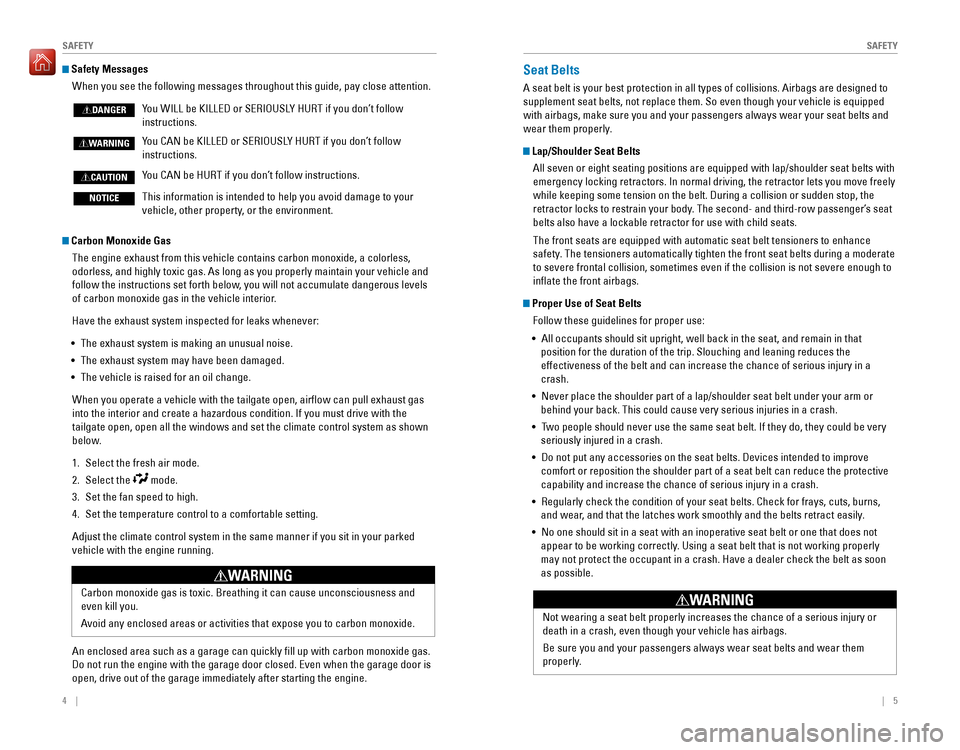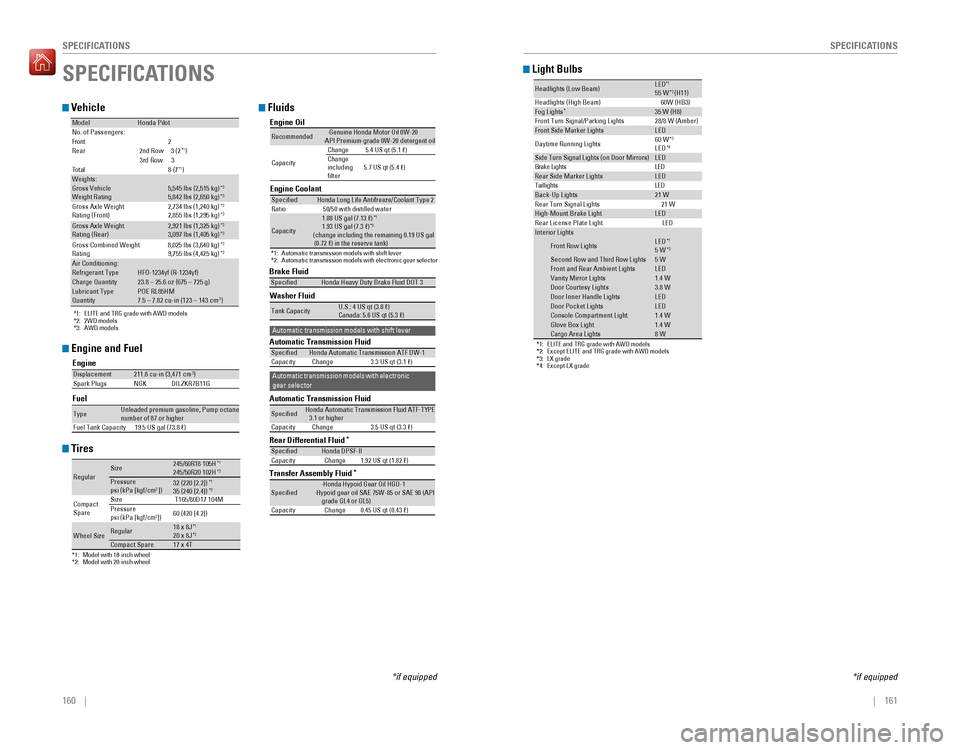gas type HONDA PILOT 2016 3.G Quick Guide
[x] Cancel search | Manufacturer: HONDA, Model Year: 2016, Model line: PILOT, Model: HONDA PILOT 2016 3.GPages: 89, PDF Size: 5.82 MB
Page 6 of 89

4 || 5
SAFETYSAFETY
Carbon Monoxide Gas
The engine exhaust from this vehicle contains carbon monoxide, a colorle\
ss,
odorless, and highly toxic gas. As long as you properly maintain your ve\
hicle and
follow the instructions set forth below, you will not accumulate dangerous levels
of carbon monoxide gas in the vehicle interior.
Have the exhaust system inspected for leaks whenever:
• The exhaust system is making an unusual noise.
• The exhaust system may have been damaged.
• The vehicle is raised for an oil change.
When you operate a vehicle with the tailgate open, airflow can pull ex\
haust gas
into the interior and create a hazardous condition. If you must drive wi\
th the
tailgate open, open all the windows and set the climate control system a\
s shown
below.
1. Select the fresh air mode.
2. Select the mode.
3. Set the fan speed to high.
4. Set the temperature control to a comfortable setting.
Adjust the climate control system in the same manner if you sit in your \
parked
vehicle with the engine running.
Carbon monoxide gas is toxic. Breathing it can cause unconsciousness and\
even kill you.
Avoid any enclosed areas or activities that expose you to carbon monoxide\
.
WARNING
An enclosed area such as a garage can quickly fill up with carbon mono\
xide gas.
Do not run the engine with the garage door closed. Even when the garage \
door is
open, drive out of the garage immediately after starting the engine.
Safety Messages When you see the following messages throughout this guide, pay close att\
ention.
You WILL be KILLED or SERIOUSLY HURT if you don’t follow
instructions.
You CAN be KILLED or SERIOUSLY HURT if you don’t follow
instructions.
You CAN be HURT if you don’t follow instructions.
This information is intended to help you avoid damage to your
vehicle, other property , or the environment.
DANGER
WARNING
CAUTION
NOTICE
Seat Belts
A seat belt is your best protection in all types of collisions. Airbags \
are designed to
supplement seat belts, not replace them. So even though your vehicle is \
equipped
with airbags, make sure you and your passengers always wear your seat belts and
wear them properly.
Lap/Shoulder Seat Belts
All seven or eight seating positions are equipped with lap/shoulder seat\
belts with
emergency locking retractors. In normal driving, the retractor lets you \
move freely
while keeping some tension on the belt. During a collision or sudden sto\
p, the
retractor locks to restrain your body. The second- and third-row passenger’s seat
belts also have a lockable retractor for use with child seats.
The front seats are equipped with automatic seat belt tensioners to enha\
nce
safety. The tensioners automatically tighten the front seat belts during a mod\
erate
to severe frontal collision, sometimes even if the collision is not seve\
re enough to
inflate the front airbags.
Proper Use of Seat BeltsFollow these guidelines for proper use:
• All occupants should sit upright, well back in the seat, and remain in t\
hat
position for the duration of the trip. Slouching and leaning reduces the\
effectiveness of the belt and can increase the chance of serious injury \
in a
crash.
• Never place the shoulder part of a lap/shoulder seat belt under your arm\
or
behind your back. This could cause very serious injuries in a crash.
• Two people should never use the same seat belt. If they do, they could be\
very
seriously injured in a crash.
• Do not put any accessories on the seat belts. Devices intended to improv\
e
comfort or reposition the shoulder part of a seat belt can reduce the pr\
otective
capability and increase the chance of serious injury in a crash.
• Regularly check the condition of your seat belts. Check for frays, cuts,\
burns,
and wear, and that the latches work smoothly and the belts retract easily.
• No one should sit in a seat with an inoperative seat belt or one that do\
es not
appear to be working correctly. Using a seat belt that is not working properly
may not protect the occupant in a crash. Have a dealer check the belt as\
soon
as possible.
Not wearing a seat belt properly increases the chance of a serious injur\
y or
death in a crash, even though your vehicle has airbags.
Be sure you and your passengers always wear seat belts and wear them
properly.
WARNING
Page 84 of 89

160 || 161
SPECIFICATIONS
SPECIFICATIONS
Vehicle
*1: ELITE and TRG grade with AWD models
*2: 2WD models
*3: AWD models
ModelHonda PilotNo. of Passengers:
2
tnorF
Rear 2nd Row3 (2
*1)
3rd Row3 7( 8
latoT
*1)Weights:Gross Vehicle
Weight Rating5,545 lbs (2,515 kg)*25,842 lbs (2,650 kg)*3Gross Axle Weight
Rating (Front)2,734 lbs (1,240 kg)*22,855 lbs (1,295 kg)*3
Gross Axle Weight
Rating (Rear)2,921 lbs (1,325 kg)*23,097 lbs (1,405 kg)*3
Gross Combined Weight
Rating 8,025 lbs (3,640 kg
)*29,755 lbs (4,425 kg)*3Air Conditioning:Refrigerant TypeHFO-1234yf (R-1234yf)Charge Quantity23.8 – 25.6 oz (675 – 725 g)Lubricant TypePOE RL85HMQuantity 7.5 – 7.82 cu-in (123 – 143 cm )3
Engine and Fuel
Engine
FuelDisplacement211.8 cu-in (3,471 cm3)
Spark Plugs NGKD ILZKR7B11G
TypeUnleaded premium gasoline, Pump octane number of 87 or higher
Fuel Tank Capacity 19.5 US gal (73.8 �)
Tires
*1:Model with 18-inch wheel*2:Model with 20-inch wheel
RegularSize245/60R18 105H*1245/50R20 102H*2Pressure
psi (kPa [kgf/cm2])35 (240 [2.4])
Compact
Spar e Size
T165/80D17 104M
Pressure
psi (kPa [kgf/cm
2]) 60 (420 [4.2])
Wheel SizeRegula
r18 x 8J*120 x 8J*2Compact Spar e17 x 4T
*232 (220 [2.2])*1
Fluids
Washer Fluid
Tank Capacit yU.S.: 4 US qt (3.8 �)
Canada: 5.6 US qt (5.3 �)
Brake FluidSpeci�edHonda Heavy Duty Brake Fluid DOT 3
Automatic Transmission Fluid
Automatic Transmission Fluid
Rear Differential Fluid*
Transfer Assembly Fluid*
Speci�edHonda Automatic Transmission ATF DW-1
Capacity Change3 .3 US qt (3.1 �)
Speci�edHonda Automatic Transmission Fluid ATF-TYPE
3.1 or highe r
Capacity Change3 .5 US qt (3.3 �)
Speci�edHonda DPSF-I I
Capacity Change 1.92 US qt (1.82 �)
Speci�ed·Honda Hypoid Gear Oil HGO- 1
·Hypoid gear oil SAE 75W-85 or SAE 90 (API
grade GL4 or GL5)
Capacity Change 0.45 US qt (0.43 �)
Automatic transmission models with shift lever
Automatic transmission models with electronic
gear selector
Engine Oi l
Engine Coolan t
*1: Automatic transmission models with shift lever
*2:Automatic transmission models with electronic gear selector
Recommended·Genuine Honda Motor Oil 0W-2 0
·API Premium-grade 0W-20 detergent oi l
Capacity Change
5.4 US qt (5.1 �)
Change
including
�lter 5.7 US qt (5.4 �)
Speci�e
dHonda Long Life Antifreeze/Coolant Type 2
Ratio 50/50 with distilled wate r
Capacity
1.88 US gal (7.13 �)*1
1.93 US gal (7.3 �)*2(change including the remaining 0.19 US gal
(0.72 �) in the reserve tank )
SPECIFICATIONS
*if equipped
Light Bulbs
*1: ELITE and TRG grade with AWD models
*2: Except ELITE and TRG grade with AWD models
*3: LX grade
*4: Except LX grade
Headlights (Low Beam)LED*155 W*2 (H11 )
Headlights (High Beam) 60W (HB3)
Fog Lights*35 W (H8)
Front Turn Signal/Parking Lights
Front Side Marker LightsLE D
Daytime Running Lights 60
W*3LED*4Side Turn Signal Lights (on Door Mirrors)LED
DEL
sthgiL ekarB
Rear Side Marker LightsLE D
DEL
sthgilliaT
Back-Up Lights21 W
Rear Turn Signal Lights 21 W
High-M ount Brake Ligh tLED
Rear License Plate Light LED
Interi or Lights
Front Row LightsLED
5 W
Second Row and Third Row Light s5 WFront and Rear Ambient LightsLE DVanity Mirror Lights 1.4 WDoor Courtesy Light s3.8 WDoor Inner Handle Light sLEDDoor Pocket LightsLEDConsole Compartment Ligh t1.4 WGlove Box Ligh t1.4 WCargo Area Lights8 W
*1
*2
28/8 W (Amber)
*if equipped